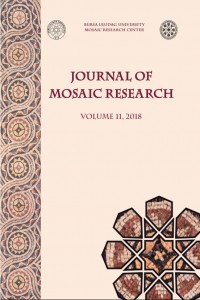Abstract
Bu makale, 60'ların sonunda Beyrut'tan Asfar Kardeşler (Asfar Brothers) özel koleksiyonunda yer alan, günümüzde ise Barselona'daki J. Bagot Arkeoloji ve Antik Sanat'ta bulunan, antika müzayedesinden bir mozaikteki Pothos betimini ele almaktadır. Özellikle de, Pelops ve Hippodameia ile ilgili bir sahnede Pothos'un yorumlanması tartışılacaktır. Üç karakterin de sıra dışı bir ikonografi ile betimlenmesine rağmen, karakterlerin teşhisi hiç kuşkusuz Yunanca yazıtlara dayanılarak yapılmıştır. Bu tartışmaya devam etmek için, bu çalışmada, antik yazılı kaynakların yanı sıra başka mozaiklerde betimlenen Pothos tasvirleri de ele alınacaktır. Ele alınacak mozaikler arasında 1979'da Londra Antika Müzayedesi'nde yer alan, 1990'lara kadar Kaliforniya'da özel bir koleksiyonun parçası olan ve 2010'da New York'ta Christie's'te açık artırmaya çıkarılan Pelops ve Hippodameia betimli bir mozaik ve Philippopolis'ten Dionysos ve Ariadne'nin evlenmesi sahnesinin görüldüğü bir mozaik de yer almaktadır.
Günümüzde J. Bagot Arkeoloji ve Antik Sanat'ta korunan mozaik üzerindeki sahneyi anlayabilmek için bazı yazılı kaynaklardan alınacak referanslar ve bu iki mozaikteki tasvirleri yorumlamak gerekmektedir.
Keywords
References
- Balty 1977 J. Balty, Mosaïques antiques de Syrie, Bruselas.
- Bazant 1994 J. Bazant, “s.v. Pothos I”, LIMC VII, 1/2.
- Gabelmann 1986 H. Gabelmann, “Endymion”, LIMC III.
- Gury 1994 F. Gury, “Selene”, LIMC VII.
- Neira 2015 L. Neira, “Written and Visual Culture about the mosaic of Castulo. The influence of Lucian’s Works”, JMR 8, 61-79.
- Pipili 1990 M. Pipili, “Hippodameia I”, LIMC V/1.
- Valero 2016 M. A. Valero, “La iconografía del mito de Pélope e Hipodamía en la musivaria romana. Nuevas aportaciones a partir del mosaico de Noheda”, AnCord 27, 125-160.
- Bilingual Greek-English edition (initial introduction, some explanatory notes):
- Rouse 1940 W. H. D. Rouse, Nonnos, Dionysiaca, With an English Translation by W. H. D. Rouse, Mythological Introduction and Notes by H. J. Rose, Notes on Text Criticism by L. R. Lind, 3 vols., Loeb Classical Library, Cambridge.
On the Interpretation of Pothos in a Mosaic from the Antiquities Market with the Representation of Pelops and Hippodameia
Abstract
This paper analyzes a representation of Pothos in a mosaic auctioned in the antiquities market, –from a private collection after being acquired at Asfar Brothers, Beirut, in the late 60's. -, today in J. Bagot Archaeology-Ancient Art in Barcelona. More specifically, we will discuss, its interpretation within a scene related to Pelops and Hippodameia. Even the three characters are represented, with an unusual iconography, their identification is undoubtedly established on the base of inscriptions in Greek. To proceed with this discussion, this study analyzes the ancient literary sources and the images of Pothos depicted in the other mosaics, among others, on a mosaic of Pelops and Hippodameia from London antique market in 1979, that had been part of a private collection of California until the 1990s, being auctioned at Christie's in New York on 2010, and in the mosaic of the Weddings of Dionysus and Ariadne from Philippopolis.
In connection with the references of some literary sources, the representations of these two mosaics are very revealing to understand the mosaic scene currently conserved in J. Bagot.
Keywords
References
- Balty 1977 J. Balty, Mosaïques antiques de Syrie, Bruselas.
- Bazant 1994 J. Bazant, “s.v. Pothos I”, LIMC VII, 1/2.
- Gabelmann 1986 H. Gabelmann, “Endymion”, LIMC III.
- Gury 1994 F. Gury, “Selene”, LIMC VII.
- Neira 2015 L. Neira, “Written and Visual Culture about the mosaic of Castulo. The influence of Lucian’s Works”, JMR 8, 61-79.
- Pipili 1990 M. Pipili, “Hippodameia I”, LIMC V/1.
- Valero 2016 M. A. Valero, “La iconografía del mito de Pélope e Hipodamía en la musivaria romana. Nuevas aportaciones a partir del mosaico de Noheda”, AnCord 27, 125-160.
- Bilingual Greek-English edition (initial introduction, some explanatory notes):
- Rouse 1940 W. H. D. Rouse, Nonnos, Dionysiaca, With an English Translation by W. H. D. Rouse, Mythological Introduction and Notes by H. J. Rose, Notes on Text Criticism by L. R. Lind, 3 vols., Loeb Classical Library, Cambridge.
Details
| Primary Language | English |
|---|---|
| Subjects | Archaeology |
| Journal Section | Article |
| Authors | |
| Publication Date | November 30, 2018 |
| Published in Issue | Year 2018 Issue: 11 |

